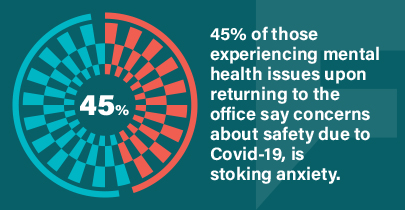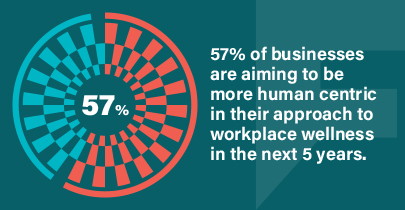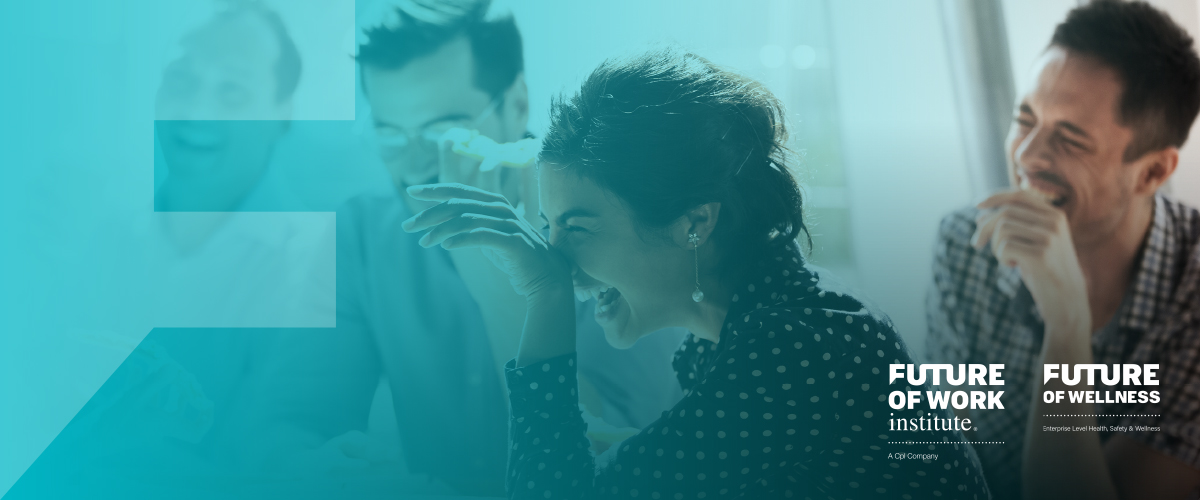Putting people at the centre of your return to office plan
‘May you live in interesting times’ is a curse dressed as a blessing. The ironic expression wishes you the turbulence and trouble of constant change over the preferred calm and tranquillity of uninteresting days.
Recently, we have truly been living in interesting times, the beginning of the pandemic, found us running on full steam with adrenaline running high. We worried about our family's health, lockdowns, and vaccines. Our working lives also transformed as we reacting to our new working environment. Some of us embraced the quiet and ease of working from work, while others found the experience to be, well turbulent and troublesome.
Simply put, we are running on surge capacity.
Surge capacity is when the collection of systems we draw on for short-term survival in acutely stressful situations give us extra ability to complete tasks. We hear miracle stories of parents lifting cars to free trapped children and people running into burning buildings to save others, these people are running on surge capacity.
This extra boost of energy is hard to observe in everyday life, most studies of surge capacity focus on soldiers in combat. When a battle begins, the soldiers' minds enter an emergency phase, fuelled by surge capacity, they work together towards a shared goal. However, as adrenaline wanes, this feeling is replaced with tiredness and agitation.
We have seen the same curve of togetherness and comradeship followed by anxiety and despair effect a lot of people throughout the pandemic.
Since the start of the pandemic, research focused on the Irish population has shown spikes in anxiety (20%) and depression (22.8%). As Covid drags on, people’s resilience has started to break down, we’re past that peak surge of capacity. And as tiredness sets in, we are now entering a new phase of uncertainty and a new set of anxieties as organisations consider their return to office (RTO) protocols and our lives are set for more upheaval.
The Great Resignation
Over the past 18 months many people have used the various lockdowns and work-from-home protocols to reflect on their lifestyle and career. This has led to people pushing for radical change in their lives. Many are exploring moving to more rural locations, or completely new countries. Others are putting family first, reducing workload, and stepping back from career commitments. This massive retreat from the world of work is being referred to as The Great Resignation.
The question now for employers is:
How can they maintain their workforce and what value can they offer to keep employees happy?
According to our research, since the pandemic began, 44% of respondents (1000+ remote workers) said their priorities have shifted. A better work-life balance, and the option to work remotely now outweighing both compensation and career progression. It is only natural that we will see taking these changes into consideration as a key retention tool, particularly for those that are anxious about returning to the physical office.
What is Pandemic Flux Syndrome?
According to a recent McKinsey report, 1 in 3 people stated that the return to office shift negatively impacted their mental health. Psychologists are referring to this set of feelings and emotions as “Pandemic Flux Syndrome.” This is a crucial factor to consider when looking at corporate wellness. As Social Psychologist and Author Amy Cuddy wrote in the Washington Post recently “many people are experiencing a starkly different set of feelings — blunted emotions, spikes in anxiety and depression, and a desire to drastically change something about their lives. If this sounds familiar, you might be one of the many people experiencing what is begun to be referred to as “pandemic flux syndrome.” "

Factors driving new work anxieties
From speaking with individuals and organisations over the last number of months we see several factors contributing to new work anxieties. These factors that we've noticed at the Future of Work Institute can be split these factors into at least, four categories:
Health and Safety - 45% of those experiencing mental health issues upon returning to the office say concerns about safety due to Covid-19, is stoking anxiety. The risk of contraction or transmission of the virus to unvaccinated or at-risk loved ones at home is a major stressor. Previously people were taking direction from the government on Covid guidelines, but now we need to make these decisions ourselves and are looking to employers for help and guidance.
Managing Work-life Balance – We are seeing very mixed views on work-life balance and flexibility. According to our Remote Working report, 60% of workers feel working from home has had a positive effect on their well-being. However, there were others who struggled with remote work. A 2021 report by Statista, found 27% of those who struggled with working remotely's biggest issue was being unable to switch off. Equally, working parents are worried that they won’t be afforded the same flexibility to take care of family once they return to the office. For them, the pandemic has also led to a rise in the prices of childcare and a reduction in available facilities. There is a real fear that parents will struggle with balancing their family priorities and responsibilities with their employers’ new and evolving policies.
Changing Team and Social Dynamics – Individuals are worried about personal relationships; they fear the in-person connections they had pre-pandemic will have fizzled out or they will not click with anyone in the office. These worried may impact the team and social dynamics or impact productivity. Enviably, these fears will lead to some unrest and new social behaviours, or at worst, social exclusion may occur.
Old Office Settings – Some people found that they were much more productive at home than in the office and are worried about their output rate dropping. For others perhaps, the office wasn’t the best experience in the first place. For example, people who have experienced bullying in work now have increased fears and anxieties about returning to a stressful environment.
Organisations, leaders, and HR Departments have a challenge on their hands when it comes to creating a return to office protocol that considers individuals' wellbeing needs and creates a sense of psychological safety. This is just one of the reasons why a people-first approach to corporate wellness is paramount during this initial phase of returning to the office.

Human-Centric Workplace Wellness
Our recent Future of Work Whitepaper suggests 57% of businesses are aiming to be more human-centric in their approach to workplace wellness over the next 5 years. Much of this will include understanding the total human experience in an organisation and the employee as a whole person, including their complex personal life. Taking a personalised approach to corporate wellness strategies can really help understand employee needs. In these changing times, there is a strong need to take a different approach to wellness and one that has the person at the core. When we think about building a sustainable and responsible business, we need to reimagine our approach to what wellbeing in the workplace means.
Psychological Safety in the Workplace
Psychological safety means listening to your employees and understanding the anxieties they are faced with when returning to the office. It also means acting and using these considerations to put measures in place to help mitigate fears. Ensuring that your managers lead with empathy and care is a key soft skill emerging from the pandemic.
So, while the organisation may not have all the answers for the vast array of anxieties, fears, and phobias an individual may be dealing with, the take home point is that managing psychological safety isn’t as simple as providing meditations and stress management seminars. It’s about considering the human and their individual needs. It’s about putting interventions in place that are preventative.
For example, a recent McKinsey report showed that 62% of employees state that improved air filtration could decrease the stress they experienced returning on-site. It also highlighted that 60% of office returners reported that flexible work schedules and hybrid working arrangements (57%) contributed to reduced stress and anxiety.
Employers can potentially reduce worker stress and anxiety and help employees refuel after surge capacity burnout by considering mental health as part of a holistic workplace wellness strategy.
Bringing mental health strategies under the wellness umbrella will also reduce risks of significant, but unaddressed mental health issues, which should not be ignored.
If we don’t ask employees what might help ease their worries, we run the risk of increased stress by taking a blanket approach.
As we all look to adjust to a new way of working, perhaps it’s best to return to that old saying, ‘May you live in interesting times’ and realise while we cannot change the turbulence of the world around us, we can construct a calm and tranquil space within it, which makes us all feel just a little bit more secure.
If you’d like to learn more about our Workplace Wellness Programmes and how we can help your company in this time of change contact me directly or
download our brochure

*Source: Why this stage of the pandemic makes us so anxious, research by Washington Post, August 2021.
*Source: Anxiety and depression in the Republic of Ireland during the COVID-19 pandemic, research by PubMed.gov, September 2020.
*Source: The Great Resignation of 2021, research by Newstalk, July 2021.
*Source: Returning to work: Keys to a psychologically safer workplace, research by McKinsey, July 2021.
*Source: Future Working Report: How to Win & Keep Talent in a Remote Working World, research by Cpl, 2021.
*Source: Minister says price hike in creche fees ‘not justified’ as parents prepare for return to office, research by The Independent, June 2021.
*Source: What's your biggest struggle with working remotely? research by Statista, March 2021.
*Source: Future of Work World : Perspectives and Pathways on the Future of Work, research by Future of Work Institute, Cpl, 2021
